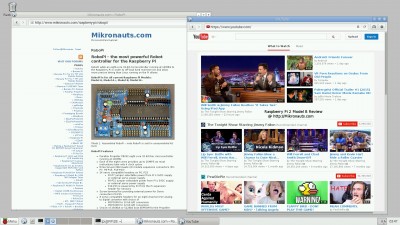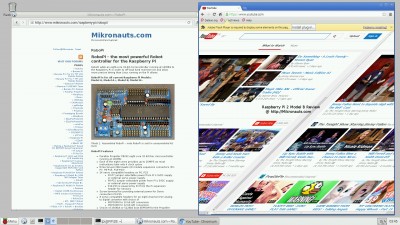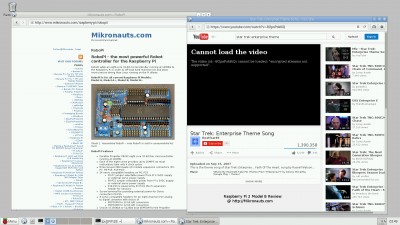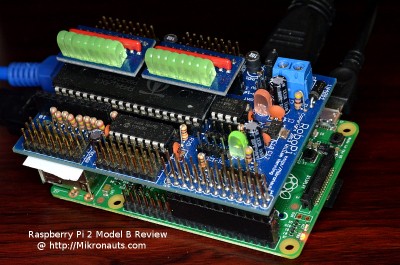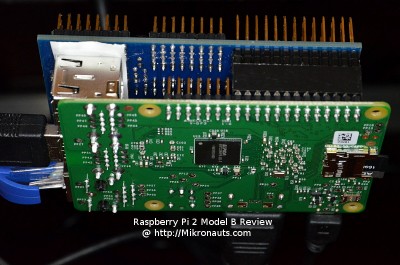Raspberry Pi 2 Model B Review
2) Common Applications
One of the first things I do on a new SBC is see if some of my most used – and favorite – software packages are available, and can be installed.
Here are my results for the Raspberry Pi 2 Model B:
- sudo apt-get install gimp
- sudo apt-get install scrot
- sudo apt-get install gedit
- sudo apt-get install joe
- sudo apt-get install libreoffice
- sudo apt-get install chromium
- SimpleIDE – worked using Raspberry Pi instructions
- sudo apt-get install xrdp
- sudo apt-get install remmina
All in all, I did not have any problems with normal Debian packages.
3) GPIO
The new Raspberry Pi 2 Model B has 1GB of ddr3 memory… which caused the base address of I/O register to move from 0x20000000 to 0x3F000000. The registers had to be mapped below 0x40000000 due to architectural restrictions of the SOC design.
This has caused basically every GPIO oriented package and library written for the previous generation of Raspberry Pi’s to break on the new Raspberry Pi 2 Model B. Fortunately a new API call was added, so new revisions of the libraries and GPIO oriented software can get the proper base address to use, and thus be compatible with both the single and quad core Pi’s.
I had no problems compiling and using the new versions of WiringPi and RPi.GPIO, and I expect that very soon a simple ‘sudo apt-get upgrade’ will install them for you.
4) Memory
I ran a posting in the Raspberry Pi 2 Q&A thread that had me concerned. Apparently, for some reason SonicPi (neat audio software) did not work when the full 1GB of memory was enabled, so the initial Raspbian shipped with the memory usable by programs capped at 740MB.
I was not happy about this state of affairs, and I did not want to wait a couple of weeks to use the full gigabyte of memory on my shiny new Pi 2B’s… so I asked for a fix, or a package I can install.
Dom, one of the Raspberry Pi Engineers, responded quickly, and posted that a simple ‘rpi-update’ (thanks Dom) would load firmware that enabled all of the memory – but which was incompatible with SonicPi.
Needless to say, my Raspberry Pi 2 Model B is running the updated firmware 🙂
5) Multimedia
(click on image for larger version)
The first thing I tried with the default web browser was to bring up my site… it rendered fine.
Next, I thought I’d take a peek at YouTube. It came up nicely… and some videos played, if slowly, when running windowed.
(click on image for larger version)
Next, I thought I’d install Chromium, and see if it worked better with videos.
Ummm…. Not so much.
(click on image for larger version)
I tried to play the Enterprise theme song.. and got a DRM failure.
I expect the multi-media situation to get better very fast… OpenElec should be running shortly, and html5 will help.
Basically, the multimedia situation with the Raspberry Pi 2 Model B should be better than that with the older Raspberry Pi’s, as soon as XBMC/Kodi/OpenElec are updated, and html makes more inroads.
Update: DougieLawson told me that OpenElec is now available for the Pi 2 B!
Hardware Compatibility
I thought I’d test some of my favourite boards that I know work well on Raspberry Pi Model A/A+/B/B+ with the new Pi.
You will see that I’ve added white electrical tape to prevent shorts with the longer boards.
RoboPi
(click on image for larger version)
RoboPi plugged right in, and it only uses TX, RX, GPIO#17, GND, and 5V so it works well on either 26 or 40 GPIO boards.
I downloaded the package of C/C++/Python libraries and demos, and it worked right away.
(click on image for larger version)
Here is another angle showing the stacked boards from the bottom.
Article Index
